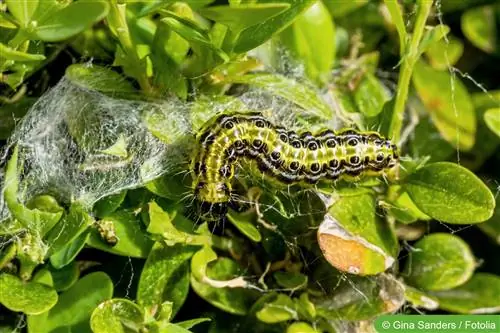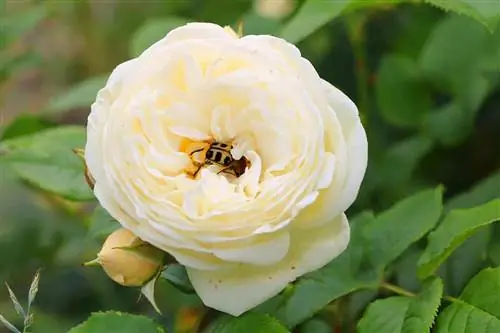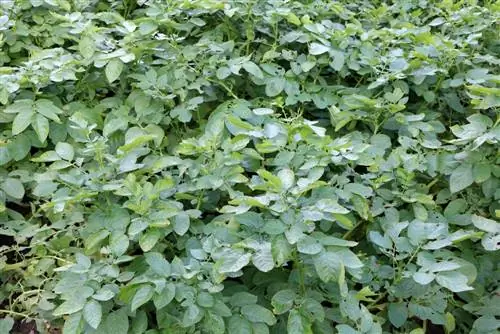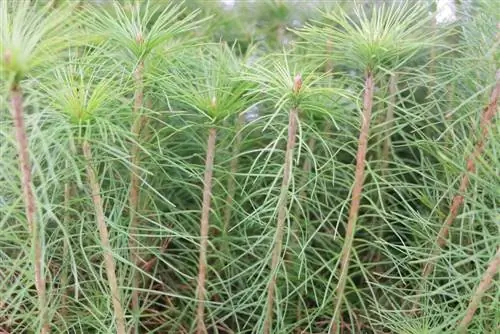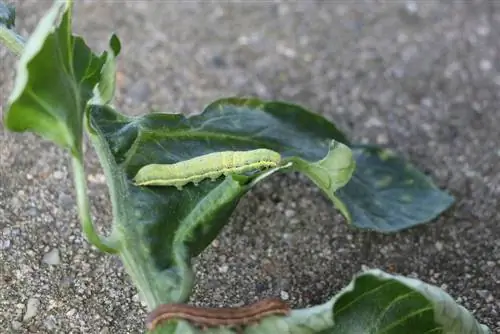- Author admin [email protected].
- Public 2023-12-17 03:39.
- Last modified 2025-01-24 12:45.
Pests introduced from Asia have been causing devastating damage to boxwood since 2006. We're talking about the voracious caterpillars of the boxwood moth, an Asian butterfly that is spreading explosively throughout Europe. While the brood goes through several larval stages, it destroys gigantic stands of boxwood by eating away the leaves and causing millions in damage. It has now been possible to develop effective mechanical, chemical and biological methods to combat the caterpillars. The following explanations provide an overview of the current state of knowledge including actionable control measures.
Information on the boxwood moth
- Scientific name: Boxwood moth (Cydalima perspectalis)
- small butterfly introduced from East Asia in 2006
- Wingspan 40 to 45 mm
- silky white wings with brown edges or brown wings with white dots
- green caterpillars, black or white stripes, black dots
- Growth during seven larval stages from 3 mm to 5 cm
- Development of at least 2 generations per year
- Overwintering in cocoons inside the boxwood
- Feeding activity starts at 7 °C in March or April
malicious image
The first damage to boxwood occurs as soon as temperatures exceed 7 °C in March/April. The larvae from the last egg-laying of the previous year overwintered in dense cocoons within the plants. Now they become active by eating the evergreen leaves of the Buxus from below. As the caterpillars go through several larval stages, they grow significantly from 3-5 mm to a whopping 5 cm. This pronounced growth consumes a large amount of energy, which is covered by extreme deforestation. You can recognize the infestation by these symptoms:
- in early spring there are gray cocoons in the boxwood
- At the beginning of the activities you can see eroded leaves inside
- he althy foliage alternates with leaf veins and petioles
- light beige areas indicate dried plant parts
As it progresses, the boxwood is partially or completely surrounded by dense webs. If you look closely, you can see light green droppings on the ground under the bush.
Tip:
The butterflies themselves do not stay on box trees, but settle on plants in the immediate vicinity. A boxwood borer only visits the bush for a short time to lay eggs on the underside of the leaves.
Combat caterpillars mechanically
In an early infestation stage, there are good prospects of driving the voracious pests away from the boxwood. Although the plague was only introduced a few years ago, a well-founded we alth of experience has now accumulated. The following mechanical control techniques achieved good success:
Collect
Ecologically responsible hobby gardeners are already using this method of pest control in some respects. What works excellently for slugs and beetles is also successful for boxwood caterpillars.
High-pressure cleaner
If the infestation pressure is already too high for the plague to be removed simply by collecting it, the high-pressure cleaner is used. This is how it works:
- Spread a sheet of foil under the boxwood until it is close to the root neck
- Spray vigorously from above and below with the high-pressure cleaner
- To be on the safe side, repeat the process several times throughout the day
Light trap
Light traps can be used to strengthen the attack against small butterflies, as the adult insects also travel at night. Sticky traps are equipped with light in the spectral range of ultraviolet radiation. In a catching radius of 10 to 15 meters, they attract the boxwood moths and thus prevent further egg laying. However, light traps are not efficient enough to exclusively combat pests on boxwood.
Biologically counteracting caterpillars
In contrast to chemical preparations, biological control methods score points with their functionality that is gentle on beneficial insects. Especially in natural gardens, no one has any interest in harming busy bees, bumblebees, birds or other beneficial insects.
Bacillus thuringiensis
As a naturally occurring bacterium, Bacillus thuringiensis has established itself worldwide as a pesticide in organic farming. It acts specifically on the caterpillars without causing any harmful effects on plants, vertebrates or humans. How to use the remedy:
- as a spray, preferably applied in a pressure sprayer
- applicable from a constant outside temperature above 15 °C
- After waiting 10 to 12 days, inject the food poison again
Neemoil
In the boxwood borer's Asian homelands, gardeners there achieved good control success with preparations based on neem oil. The vegetable oil is obtained from the seeds of the neem tree, which contain the natural insecticide azadirachtin. Neem oil has an immediate fatal effect on the caterpillars on infested boxwood trees. It is recommended to apply the preparation in liquid form using a pressure sprayer. This way the plant can be completely treated with it.
Pheromone trap
Such a trap specifically emits an attractant that attracts the male boxwood moths. You end up in a glue trap from which there is no escape. Pheromone traps help plagued hobby gardeners in two ways to combat boxwood caterpillars. First and foremost, they inhibit further reproduction of the pests because the males are eliminated. Secondly, they provide information about the optimal time for combating them. For this purpose, commercially available attractant traps are equipped with a counting grid.
Tip:
During the cold season, neither biological nor chemical insecticides work against boxwood caterpillars. The pests protect themselves in dense cocoons that no agent has yet been able to penetrate.
Proven insecticides
A high level of infestation leaves affected gardeners with little choice but to resort to chemical sprays. In particular, preparations containing the ingredients thiacloprid and acetamiprid destroy boxwood caterpillars. In Germany and Switzerland, the active ingredients are still approved for use in allotment gardens. The following products are recommended by the Chambers of Agriculture in Germany:
- Bayer Garten watering agent against pests Calypso
- Celaflor Careo Pest Free
- Compo Thriathlon Universal insect-free
- Etisso Pest Free
All substances are classified as harmful to he alth by the EU. This circumstance implies the observance of strict precautionary measures during use. Since the spray agents only work effectively if they are applied at high pressure, special protective clothing is strongly recommended, including respiratory protection. The database of the Federal Office of Consumer Protection and Food Safety (BVL) provides a detailed overview of all currently approved plant protection products.
Conclusion of the editors
The shock was deep when the introduced box tree borer destroyed huge populations within just a few years. Today, hobby gardeners no longer have to admit defeat to pests because effective control measures have emerged. In the early stages of infestation, mechanical procedures such as collecting or spraying with a high-pressure cleaner provide relief. In addition to the bacterium Bacillus thuringiensis, preparations containing neem oil and pheromone traps have proven to be effective biological agents. If the pests have already spread invasively, various insecticides are available to effectively combat the caterpillars.
What you should know about boxwood pests in brief
Unlike other garden plants, Buxus is only attacked by pests that only favor this plant. There are three pests in particular that affect the plant: the boxwood psyllid, the boxwood spider mite and the boxwood borer.
Boxwood flea
- The boxwood psyllid usually attacks the Buxus in spring when new leaves can be seen, usually from May.
- These pests on Buxus (boxwood) suck on the young leaves and deposit their larvae on the protected undersides of the leaves.
- You can tell that the Buxus is infested with this pest by the upwardly curved leaves.
- Another characteristic: small white balls or a white coating on the leaves, which indicate that the pest has laid its larvae there.
- Spraying crop protection products containing rapeseed oil at the time the leaves are emerging can help if the pests take over large parts of the plant.
- Partial infestation can be prevented by careful pruning.
Box tree spider mite
- Another pest is the boxwood spider mite. This also only affects the Buxus.
- These pests on Buxus (boxwood) can be recognized just as easily as spider mites in general, although the signs differ.
- The boxwood spider mite sucks in the leaves, but does not spin such distinctive webs around the leaves and shoots.
- Here you can use the same pesticides as for boxwood psyllids, but you should treat the plant in spring.
- This mainly prevents the boxwood spider mite from laying its eggs under the leaves.
Boxwood moth
- The boxwood moth, which comes from China, is also known to be a pest on Buxus (boxwood).
- This is a type of butterfly whose caterpillars eat the leaves of the box tree.
- As an antidote, only special preparations or collecting the caterpillars can help.
- So far, however, the boxwood moth has only been found in southern Germany.
- However, further expansion to the north can be expected in the next few years!

